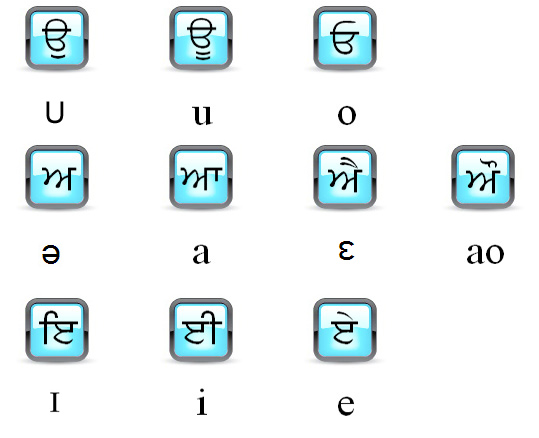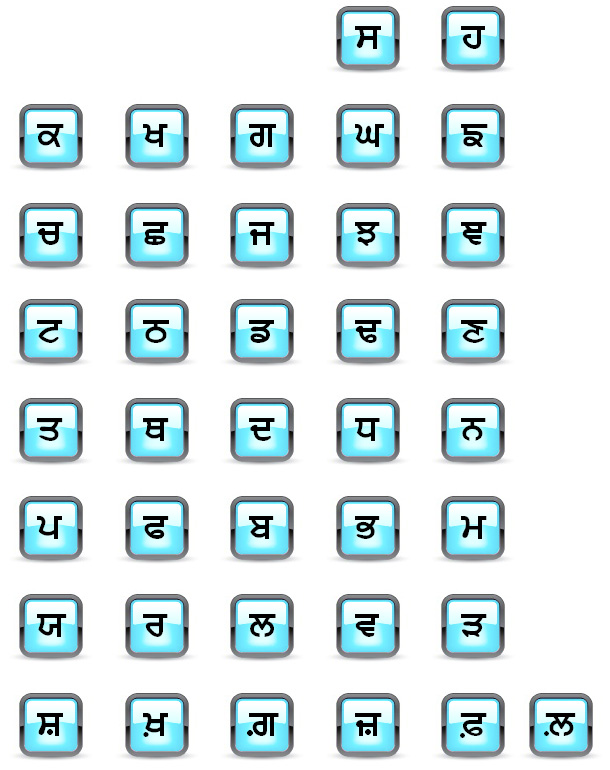 |
| Subject Expert |
: |
|
Dr. Amritpal Kaur
Professor, Department of Punjabi Literary Studies
Punjabi University, Patiala
Dr. Devinder Singh
Assistant Professor. Department of Linguistics and Punjabi Lexicography, Punjabi University, Patiala.
Punjabi University, Patiala |
| Voice Over |
: |
|
Ms. Raman Chahal |
|
 |
| |
|
|
|
| |
|
|
| |
The speech sounds of a language can be classified into two categories, segmental & super-segmental sounds. The segmental sounds are further divided into two classes, vowels & consonants. The super segmental sounds are classified into stress, tone & intonation. In this part of the course, the vowels & consonants are classified.
There are three basic vowels in Gurmukhi Script. These are  . The matras are used with these three letters. After the usage of matras these letters become ten in number. With in these three . The matras are used with these three letters. After the usage of matras these letters become ten in number. With in these three  and and  letters are not used in this form. Only letters are not used in this form. Only  can occur independently. can occur independently.  and and  occur with the usage of matras. The matras are used with these three letters as follows. occur with the usage of matras. The matras are used with these three letters as follows. |
|
| |
|
|
| |
 ɛ ɛ |
|
| |
|
|
| |
The Alphabetical order |
|
| |
|
|
| |
 |
|
| |
|
|
| |
The Dictionary order |
|
| |
|
|
| |
 |
|
| |
|
|
| |
ਅ
While producing this vowel, the central part of the tongue is raised to an intermediate height. The lips are slightly spread. It is called a mid central unrounded short vowel.
ਆ
While producing this vowel the tongue is not raised at all and lies low. The lips are slightly spread. It is called low central unrounded vowel.
ਇ
In the production of this vowel the lips remain spread. The front part of the tongue is raised towards the hard palate. It is called lower high front unrounded vowel.
ਈ
While producing this vowel the front part of the tongue is raised to the maximum height. The lips remain spread. It is called high front unrounded vowel.
ਉ
In the production of this vowel the back part of the tongue is raised towards the soft palate. The lips are in the rounded position. It is called lower-high back rounded short vowel.
ਊ
While producing this vowel the back part of tongue is raised to the maximum height. The lips are remain in the rounded position. It is called high back rounded vowel.
ਏ
In the production of this sound the front part of the tongue is raised towards the hard palate. The lips are in the neutral position. It is called mid front unrounded vowel.
ਐ
While producing this vowel the lips remain spread in half open position. The front part of the tongue raised towards the hard palate. It is called mid-low front unrounded vowel.
ਓ
While producing this vowel the back part of the tongue raised to an intermediate height. The lips are in the rounded position. It is called mid-back rounded vowel.
ਔ
In the production of this vowel the back part of the tongue is raised towards soft palate. The lips remain in a slightly rounded position. It is called mid-low back rounded vowel. |
|
| |
|
|
 |
 |
Discription of Consonants |
 |
|
 |
|
|
| |
|
|
| |
After the classification of vowel sounds the consonant sounds are classified. These sounds are classified as velars, affricates, retroflexs, dentals, bilabials, nasals, frictionless continuants, trill, flap, laterals, fricatives & glottal.
The consonant /s/ਸ is called the alveolar fricative. The blade of the tongue approaches the teeth ridge leaving a narrow passage. The air squeezes out with friction. In the production of /h/ਹ is called the alveolar fricative. The blade of the tongue approaches the teeth ridge leaving a narrow passage. The air squeezes out with friction. In the production of /h/ਹ consonant, the air passes with a friction in the glottal region. This is called glottal fricative. consonant, the air passes with a friction in the glottal region. This is called glottal fricative.
In Gurumukhi script, the consonants / K, Kh, g/ਗ /ਕ /ਕ , ਖ , ਖ , ਗ , ਗ are velar sounds. In the production of these sounds, the back part of the tongue touches the soft palate. After releasing the contact, the air comes out with plosion. The consonants /c, ch, j/ ਚ are velar sounds. In the production of these sounds, the back part of the tongue touches the soft palate. After releasing the contact, the air comes out with plosion. The consonants /c, ch, j/ ਚ ,ਛ ,ਛ ,ਜ ,ਜ are palato-alveolar affricates. The front part of the tongue touches between the teeth ridge and the hard palate. The consonants are palato-alveolar affricates. The front part of the tongue touches between the teeth ridge and the hard palate. The consonants  , th, , th, ਟ ਟ ,ਠ ,ਠ ,ਡ ,ਡ are retroflex sounds. In the production of these sounds, the tip of the tongue called back and touches to the hard palate. The consonants like /t, th, d/ਤ are retroflex sounds. In the production of these sounds, the tip of the tongue called back and touches to the hard palate. The consonants like /t, th, d/ਤ , ਥ , ਥ , ਦ , ਦ are dental sounds. The tip of tongue touches to the back part of the teeth. When the consonants /p, ph, b/ਪ are dental sounds. The tip of tongue touches to the back part of the teeth. When the consonants /p, ph, b/ਪ , ਫ , ਫ , ਬ , ਬ are produced, the lips are brought together into contact. These are called bilabial sounds. The sounds are produced, the lips are brought together into contact. These are called bilabial sounds. The sounds  , ñ, n, , ñ, n,  , ,  / ਙ / ਙ ,ਞ ,ਞ ,ਣ ,ਣ ,ਨ ,ਨ ,ਮ ,ਮ are called velar nasal, palatal nasal, retroflex nasal, dental nasal and bilabial nasal respectively. are called velar nasal, palatal nasal, retroflex nasal, dental nasal and bilabial nasal respectively.
In the production of y/ਯ , the front part of the tongue raises towards the hard palate. This is called palatal frictionless continuant. In the production of /r/ਰ , the front part of the tongue raises towards the hard palate. This is called palatal frictionless continuant. In the production of /r/ਰ , the tip of the tongue approaches towards the alveolar ridge and taps. This is called alveolar trill sound. The /l/ਲ , the tip of the tongue approaches towards the alveolar ridge and taps. This is called alveolar trill sound. The /l/ਲ consonant is a lateral sound. The front part of the tongue touches the back of the upper teeth. The air comes out by the sides of the tongue. The sound /v/ਵ consonant is a lateral sound. The front part of the tongue touches the back of the upper teeth. The air comes out by the sides of the tongue. The sound /v/ਵ is called labio-dental. In the production of this sound, the lower teeth touches to the upper lip. The sound /r/ੜ is called labio-dental. In the production of this sound, the lower teeth touches to the upper lip. The sound /r/ੜ is called Flap. In the production of this sound, the tip of the tongue curls back and approaches the hard palate but does not make a contact. In the production of /sh/ਸ਼ is called Flap. In the production of this sound, the tip of the tongue curls back and approaches the hard palate but does not make a contact. In the production of /sh/ਸ਼ , the front part of the tongue is raised towards the hard palate leaving a narrow passage. The air comes out with friction. This is called palato-alveolar fricative. , the front part of the tongue is raised towards the hard palate leaving a narrow passage. The air comes out with friction. This is called palato-alveolar fricative.
The sound /x/ਖ਼ is called velar fricative. The back part of the tongue is raised towards the soft palate. In the production of /g/ਗ਼ is called velar fricative. The back part of the tongue is raised towards the soft palate. In the production of /g/ਗ਼ the back part of tongue is raised towards the soft palate. This sound is also called velar fricative. In the production of /z/ਜ਼ the back part of tongue is raised towards the soft palate. This sound is also called velar fricative. In the production of /z/ਜ਼ , the blade of the tongue approaches the teeth ridge. The air passes through the narrow passage with friction. This is called alvealor fricative. While producing /f/ਫ਼ , the blade of the tongue approaches the teeth ridge. The air passes through the narrow passage with friction. This is called alvealor fricative. While producing /f/ਫ਼ the lower lip approaches the upper teeth. The air comes out with friction. This sound is called labio-dental fricative. In the production of /l/ਲ਼ the lower lip approaches the upper teeth. The air comes out with friction. This sound is called labio-dental fricative. In the production of /l/ਲ਼ sound the tip of the tongue curls back and touches the hard palate. The air passes by the sides of tongue. This is called retroflex lateral. sound the tip of the tongue curls back and touches the hard palate. The air passes by the sides of tongue. This is called retroflex lateral. |
|
| |
|
|
| |
|
|
| |

|
|
| |
|
|
| |
|
|
|




